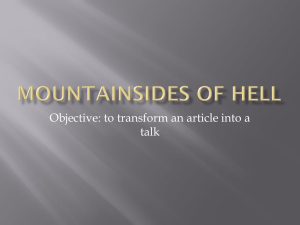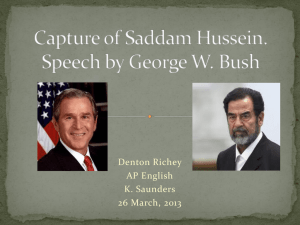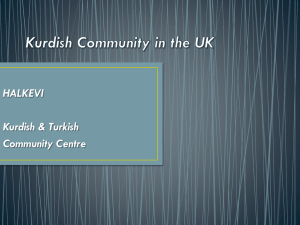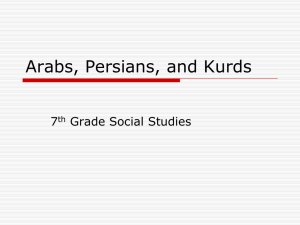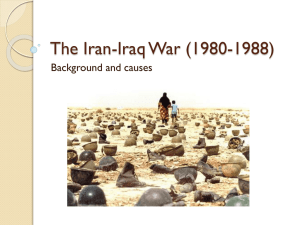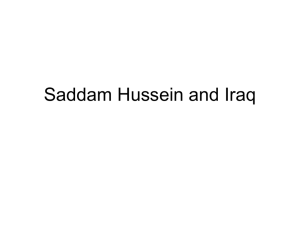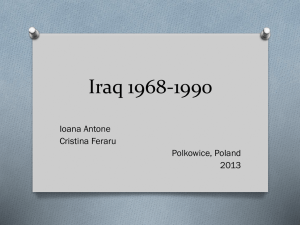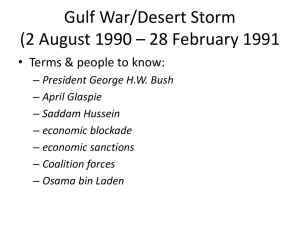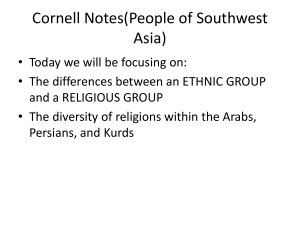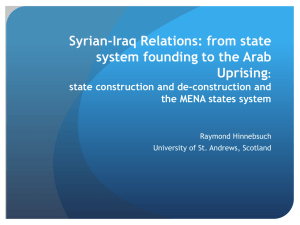Iraq - Freeman Public Schools
advertisement
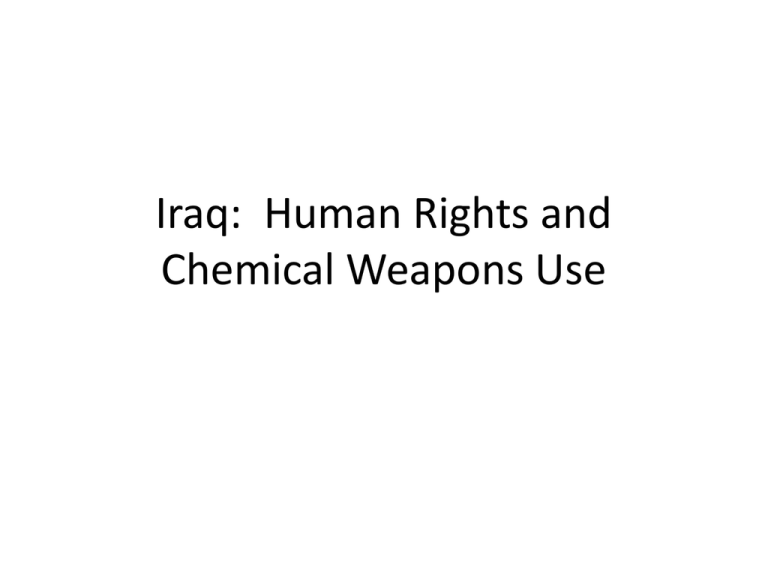
Iraq: Human Rights and Chemical Weapons Use Kurds of Iraq • Kurds are a stateless people scattered over Turkey, Syria, Iraq, and Iran • Kurds make up more than 4 million of Iraq’s population of 18 million History of Kurds • Were promised a state of their own in 1922, but Turkey refused to ratify the Treaty of Sevres and the idea was dropped. – This same pact would have required prosecution of Turks for their atrocities against the Armenians • Iraqi Kurds staged frequent rebellions in hopes of governing themselves History of the Kurds • In 1970, Iraq offered the Kurds self-rule in a Kurdistan Autonomous Region that covered half of the territory that the Kurds considered theirs. • It excluded Kurdish-populated oil-rich provinces. • Kurds reject the offer History of the Kurds • Saddam Hussein, imposed the plan unilaterally in 1974 – Kurds thought they would get support from the United States, Iran, and Israel • U.S. was concerned with Iraq’s friendship with the Soviet Union • Iran and Iraq were in a dispute over their border – Kurds revolt under their leader, Mullah Mustafa Barzani History of the Kurds • 1975, Algiers agreement temporarily settles border dispute between Iraq and Iran – Iraq agrees to recognize the Iranian border – Iran and U.S. withdraw their support for the Kurds • Without the support of Iran and U.S., Kurd revolt collapses • Kurds were treated by Saddam Hussein as traitors for aligning with the enemy History of the Kurds • Saddam ordered the 4,000 sq mi. of Kurdish territory in northern Iraq, Arabized – Imported large Arab communities (Kurds were Muslim) – Required Kurds to leave any area he considered strategically valuable • Many were deported to the southern border within 2 months • Some sources say 200,000 others say as nearly ½ a million. Two Leaders Ayatollah Khomeini Saddam Heusein Iran-Iraq War • In 1980, Iraq turned its back on the Algiers agreement that had settled the border dispute with Iran five years earlier • Iraq claimed the entire Shatt al-Arab waterway – Saddam wanted to demonstrate to the new regime of the Ayatollah Khomeini that it was the regional strongman • U.S. did not want oil reserves to fall into the hands of Khomeini, a radical Islamist Iran-Iraq War Iran-Iraq War • U.S. ends up aligned with a genocidal regime, Iran – Provides Iraq with $210 million in ag credits to buy U.S. grain – Would soon climb to $500 million a year • U.S. removes Iraq from its list of countries sponsoring terrorists • 1984- U.S. and Iran restore diplomatic relations Iran-Iraq War • U.S. knew of Hussein’s reliance on torture and executions, but U.S. could not allow Iran to defeat him. • As Iraq gained favor with U.S., the Kurds continued to lose favor with Iraq • More resettlements took place • Both major Kurdish political parties opted to team with Iran • Met with horrible consequences Iran-Iraq War • Americans had sort of written off the region and did not even complain when Hussein acquired between 2,000 and 4,000 tons of chemical weapons and experimented on the Iranians. • Iraq used chemical weapons about 195 times between 1983 and 1988, killing or wounding some 50,000 people, many of them civilians Iran-Iraq War • The most the international community mustered was a 1987 UN Security Council Resolution that generally “deplored” chemical weapons use • Once the Iraqi dictator, Hussein, knew he would not be sanctioned for using these weapons against Iran, he knew he was on to something. Iran-Iraq War • Hussein did become alarmed with press reports about American backroom arms deals with Iran • Let Peter Galbraith, a journalist?, come along on a 8 day fact finding trip in Sept. 1987 • Kurdish village after Kurdish village had been destroyed • In his report, Galbraith recommended the U.S. pursue economic sanctions against Iran and work through the United Nations to bring war to a close Iran-Iraq War • Larry Pope, State Department office director for Iran and Iraq said U.S. knew something dreadful was going on. – Knew Kurdish villages were being razed – U.S. thought these actions were temporary – Surely they would not waste precious resources destroying their own population when they were trying to win a war with Iran Iran-Iraq War • Having seen how effective chemical weapons could be against his external foe, Hussein turned them now on his chief internal enemy, the Kurds • In May 1987, Iraq became the first country ever to attack its own citizens with chemical weapons. • September 1987, New York Times notes that Iraq had dynamited some 500 villages in the past 6 months Iran-Iraq War • The American response to Iraqi chemical weapons’ use against Iran, early reports of use against the Kurds, and ongoing Iraqi bulldozing of Kurdish villages was extremely tame. Iraq-Iran War • In March 1988 Iraqi forces gassed the Kurdish town of Halabja – Halabja, a border town, was just seven miles east of a strategically vital source of water for Baghdad – Kurdish-Iranian soldiers replaced the Iraqis overnight – March 16, Iraq counterattacks with deadly gasses – Halabja became known as the Kurdish Hiroshima – 5,000 Kurds were killed immediately and thousands more injured Iran-Iraq War • Iraq justified its attacks against the Kurds on the grounds that it had to destroy the Kurdish saboteurs who with Iran. – Those who worked with Iran had obtained gas masks – It was unarmed Kurdish civilians who were left helpless Iran-Iraq War • Halabja was the deadliest single gas attack on Kurds – Was one of at least 40 other chemical assaults ordered by al-Majid Iran-Iraq War U.S. Skepticism • The gassing reports were met with U.S. skepticism – Americans distrusted Iranian sources • Used words like “allegations of gassing” – Iraq denies reports of fighting in the area – Some Kurds had taken up arms with the Iranians so was viewed by American sources as a part of war. They were lumped with the forces responsible for taking U.S. hostages Iran-Iraq War U.S. Skepticism • Since Halabja was only 15 miles from inside Iraq, Western reporters were able to witness with their own eyes – Iran was eager to provide evidence of war crimes against Iraq – Iraq led their own tours and denied the atrocities • U.S. official position was to confined to criticize weapons used – “this is a reminder to all countries why chemical warfare should be banned Iran-Iraq War U.S. Skepticism • U.S. issued no threats or demands • Claimed the proof of Iraqi responsibility was inconclusive • At UN security council, US blocked an Iranian attempt to raise question of responsibility for attack • The story of Halabja died down as quickly as it sprang up and the State Department maintained full support for Iraq Iran-Iraq War Mass Executions • Most Kurds who died in the Anfal were killed in mass executions • Senior Reagan administration officials made it plain that the fate of the Kurds was not their concern • Several Kurds survived Iraqi firing squads and later came forward to describe the horror Iran-Iraq War • U.S. and European policymakers had long refused to meet officially with the Iraqi Kurdish leaders for fear of irritating Saddam Hussein – Jalal Talabani, one leader of the Iraqi Kurds’ two main political parties, traveled to Washington, D.C. in June 1988 to gain an audience with the West. Iran-Iraq War • Larry Pope, the State Department’s Iran-Iraq office director, agreed to met with Talabani at the State Department – This meant ignoring the ordinance that all contact with the Kurds was to occur off U.S. government property • First outrage came not from Iran, but from Turkish President, Kenan Evren Iran-Iraq War • Iraqis also upset – U.S. calmed their fears and sent the message that our relations with Iraq and Turkey were more important than what Hussein was doing to the Kurds. • In late June and July the Iraqis staged chemical weapons attacks throughout Kurdish territory Iran-Iraq War • In 1987-1988, U.S. concentrated on securing an arms embargo against Iran • Gave assistance to Iraq, but did not sell them weapons – Provided them with intelligence gathered from AWACS early-warning aircraft – Gave damage estimates on Iraqi attacks – Reported Iranian troop movements • Iran saw a decrease in number of enlistments Iran-Iraq War • Khomeini agrees to a cease fire in July 1988 – More than 1 million soldiers and civilians on both sides died in the war – Not an inch of land changed hands • Aug. 20, 1988, Iran and Iraq signed an armistice • Aug. 25, 1988, Iraq launched a new attack on Kurdish villages – U.S. officials finally had to take notice Final Offensive Against the Kurds • The final offensive against the Kurds was widely known – New York Times ran a long front page story on Sept. 1, 1988 • 65,000 Kurdish victims and survivors go to Turkey Final Offensive Against The Kurds • U.S officials were reluctant to criticize Iraq and too refuge in the absence of perfect information. – Said reports from Turkish border were not unanimous. • The Regan administration’s endless search for “evidence” provided a familiar fig leaf for inaction. Aftermath • U.S. calls on the UN to send in a team of experts to Iraq to investigate. – Prior investigations had concluded in 1986, 1987, and 1988 that Iraq had used chemical weapons against Iran • By 1989 only a few hundred villages remained standing I Hussein’s “Kurdish autonomous region. – 4,049 villages had been destroyed Aftermath • George Bush Sr. takes over White House in Jan. 1989 – Iraq became the 9th largest purchaser of U.S. farm goods • 12 Western states join together at the UN Human Rights Commission and sponsor a resolution to make a through study of the human rights situation in Iraq. – U.S. refuses to join Aftermath • Oct. 2, 1989, a year after Kurds tumble into Turkey fleeing gas attacks, President Bush signs National Security Directive 26 (NSD-26) that says “normal relations between the U.S. and Iraq would serve our long-term interests and promote stability in the Gulf and Middle East.” Aftermath • April 2, 1990- Sadaam Hussein confims Iraq possesses chemical weapons – Also gives his burn Israel speech – “By God, we will make fire eat up half of Israel” if Israel attacks Iraq • A week after the sanctions bill clears the Senate, Iraq invaded Kuwait. – U.S. bombing of Baghdad begins Jan. 17, 1991 Aftermath • Feb. 15, 1991 President Bush gives a speech. “There is another way for the bloodshed to stop, and that is for the Iraqi military and Iraqi people to take matters into their own hands and force Saddam Hussein to step aside. – Feb. 27, 1991 Bush declares a cease fire – 100 hours after ground war begins • Kurds rise up in the north on March 6th Aftermath • Kurds banked on U.S. military support and overestimated the damage already inflicted on the Iraqi military by the allied attack. • Could turn into public relations disaster for U.S. • April 16, 1991, U.S. launches Operation Provide Comfort – Carves out a safe haven for Kurds in northern Iraq Justice • Today Kurdish women survivors cling to rumors that their husbands remain alive in secret jails in the desert • 70,000 Kurds have returned to Halabja where massive gas attacks took place • Survivors remain blinded from burns • Miscarriages and birth defects such as cleft palates are common Justice • High rate of lymphomas and leukemia – No radiation or chemotherapy is available • In their failed revolt against Baghdad in 1991 Kurds stormed secret police buildings and recovered documents – Were not thinking of prosecuting officials just obtaining names of informants • Records were transferred to National Archives in Washington, D.C. Justice • Human Rights Watch was granted exclusive access to the documents – In 1992 and 1993 they interviewed 350 survivors – Physicians for Human Rights exhumed mass graves and gathered forensic material • Was the kind of study a U.S. government determined to stop atrocities might have attempted while the crimes were underway Justice • Human Rights Watch found between 50,000 and 100,000 Kurds (most children and children) were executed or disappeared between Feb. and Sept. 1998 alone. • The confiscated Iraqi government records explicitly recorded the Iraqi aims to wipe out rural Kurdish life Justice • Having documented the genocide, Human Rights Watch assigned lawyer Richard Dicker to draw up a legal case in spring 1994. – His role was to prepare a tight case and persuade a state to take it on. – If a genocide case were filed, the International Court of Justice could recommend that Iraqi assets be seized and that perpetrators be punished at home, abroad, or in some international court. Justice • In July 1995, Secretary of State Warren Christopher signed a communique that found Iraq had committed genocide against Iraq’s Kurds and endorsed Human Rights Watch’s efforts to file a case against Iraq. – To this day, no Iraqi soldier or political leader has been punished for atrocities committed against the Kurds.
